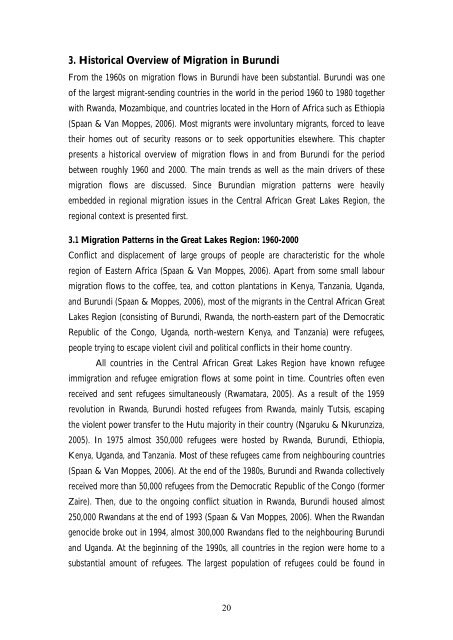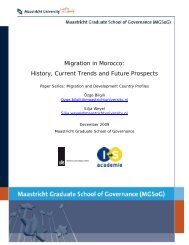Migration in Burundi: History, Current Trends and Future - MGSoG ...
Migration in Burundi: History, Current Trends and Future - MGSoG ...
Migration in Burundi: History, Current Trends and Future - MGSoG ...
Create successful ePaper yourself
Turn your PDF publications into a flip-book with our unique Google optimized e-Paper software.
3. Historical Overview of <strong>Migration</strong> <strong>in</strong> <strong>Burundi</strong><br />
From the 1960s on migration flows <strong>in</strong> <strong>Burundi</strong> have been substantial. <strong>Burundi</strong> was one<br />
of the largest migrant-send<strong>in</strong>g countries <strong>in</strong> the world <strong>in</strong> the period 1960 to 1980 together<br />
with Rw<strong>and</strong>a, Mozambique, <strong>and</strong> countries located <strong>in</strong> the Horn of Africa such as Ethiopia<br />
(Spaan & Van Moppes, 2006). Most migrants were <strong>in</strong>voluntary migrants, forced to leave<br />
their homes out of security reasons or to seek opportunities elsewhere. This chapter<br />
presents a historical overview of migration flows <strong>in</strong> <strong>and</strong> from <strong>Burundi</strong> for the period<br />
between roughly 1960 <strong>and</strong> 2000. The ma<strong>in</strong> trends as well as the ma<strong>in</strong> drivers of these<br />
migration flows are discussed. S<strong>in</strong>ce <strong>Burundi</strong>an migration patterns were heavily<br />
embedded <strong>in</strong> regional migration issues <strong>in</strong> the Central African Great Lakes Region, the<br />
regional context is presented first.<br />
3.1 <strong>Migration</strong> Patterns <strong>in</strong> the Great Lakes Region: 1960-2000<br />
Conflict <strong>and</strong> displacement of large groups of people are characteristic for the whole<br />
region of Eastern Africa (Spaan & Van Moppes, 2006). Apart from some small labour<br />
migration flows to the coffee, tea, <strong>and</strong> cotton plantations <strong>in</strong> Kenya, Tanzania, Ug<strong>and</strong>a,<br />
<strong>and</strong> <strong>Burundi</strong> (Spaan & Moppes, 2006), most of the migrants <strong>in</strong> the Central African Great<br />
Lakes Region (consist<strong>in</strong>g of <strong>Burundi</strong>, Rw<strong>and</strong>a, the north-eastern part of the Democratic<br />
Republic of the Congo, Ug<strong>and</strong>a, north-western Kenya, <strong>and</strong> Tanzania) were refugees,<br />
people try<strong>in</strong>g to escape violent civil <strong>and</strong> political conflicts <strong>in</strong> their home country.<br />
All countries <strong>in</strong> the Central African Great Lakes Region have known refugee<br />
immigration <strong>and</strong> refugee emigration flows at some po<strong>in</strong>t <strong>in</strong> time. Countries often even<br />
received <strong>and</strong> sent refugees simultaneously (Rwamatara, 2005). As a result of the 1959<br />
revolution <strong>in</strong> Rw<strong>and</strong>a, <strong>Burundi</strong> hosted refugees from Rw<strong>and</strong>a, ma<strong>in</strong>ly Tutsis, escap<strong>in</strong>g<br />
the violent power transfer to the Hutu majority <strong>in</strong> their country (Ngaruku & Nkurunziza,<br />
2005). In 1975 almost 350,000 refugees were hosted by Rw<strong>and</strong>a, <strong>Burundi</strong>, Ethiopia,<br />
Kenya, Ug<strong>and</strong>a, <strong>and</strong> Tanzania. Most of these refugees came from neighbour<strong>in</strong>g countries<br />
(Spaan & Van Moppes, 2006). At the end of the 1980s, <strong>Burundi</strong> <strong>and</strong> Rw<strong>and</strong>a collectively<br />
received more than 50,000 refugees from the Democratic Republic of the Congo (former<br />
Zaire). Then, due to the ongo<strong>in</strong>g conflict situation <strong>in</strong> Rw<strong>and</strong>a, <strong>Burundi</strong> housed almost<br />
250,000 Rw<strong>and</strong>ans at the end of 1993 (Spaan & Van Moppes, 2006). When the Rw<strong>and</strong>an<br />
genocide broke out <strong>in</strong> 1994, almost 300,000 Rw<strong>and</strong>ans fled to the neighbour<strong>in</strong>g <strong>Burundi</strong><br />
<strong>and</strong> Ug<strong>and</strong>a. At the beg<strong>in</strong>n<strong>in</strong>g of the 1990s, all countries <strong>in</strong> the region were home to a<br />
substantial amount of refugees. The largest population of refugees could be found <strong>in</strong><br />
20



